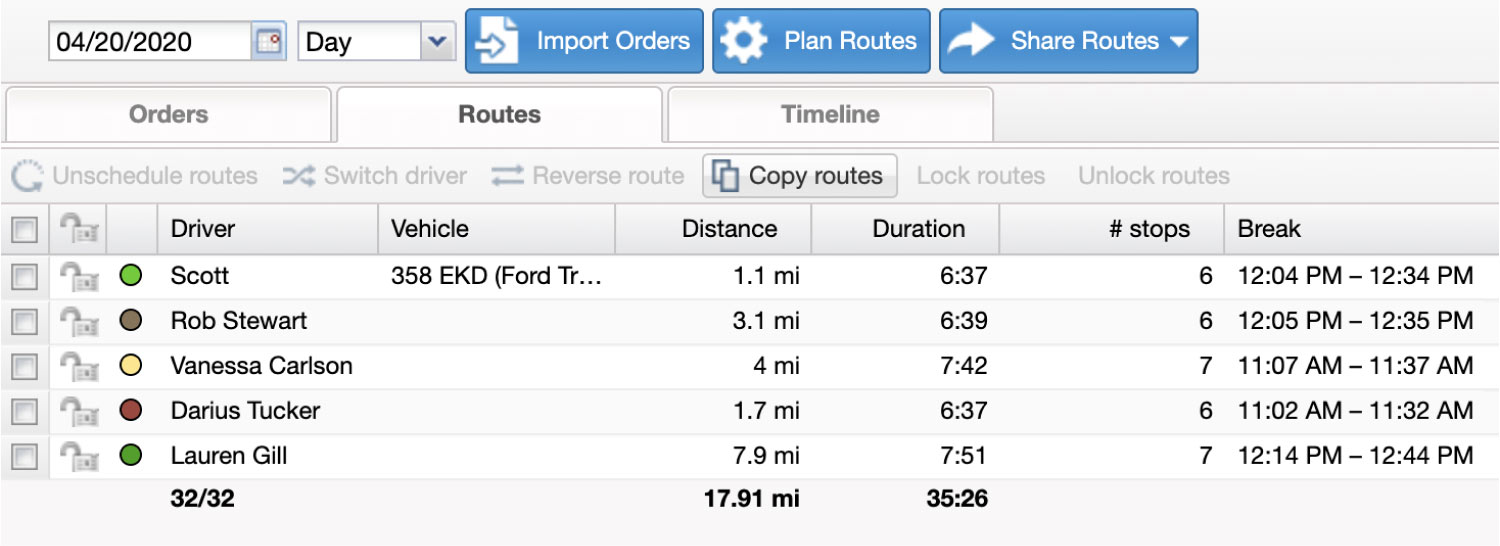ELD Short-Haul Exemptions: Are You and Your Drivers Exempt?
4 min read

Starting from December 17, 2019, all motor carriers and drivers subject to FMCSA’s ELD final rule, must use an ELD (electronic logging device).
That is, unless you’re exempt. But you better be sure, since non-compliance can mean citations, reduced CSA scores, and fines of up to $26,126 per vehicle.
Unfortunately, it can be hard to read and digest the spider web that are the FMCSA regulations, and short-haul ELD exemptions are no exception.
That’s why, in this article, we’ll help you make sense of the legalese and find out if you’re exempt from using ELDs .
If you aren’t, we’ll also cover the easiest, most affordable, and least time-consuming way to get yourself set up and compliant.
Use the links below to jump to the most relevant topic to you:
- What Is the Short-Haul Exemption?
- Requirements to Qualify for the Short-Haul Exemption
- Don’t Qualify? Here’s What You Can Do
- Go Beyond Compliance With OptimoRoute: Increase Productivity, Reduce Costs and Scale Your Business
What Is the Short-Haul Exemption?
The short-haul exemption is an exemption from rules requiring fleet management companies to track their drivers’ activity using an ELD (electronic logging device). Short-haul exemptions are available to some short-haul carriers depending on factors like how far they travel from their work reporting station (among other requirements).
The DOT’s FMCSA (Federal Motor Carrier Safety Administration), added this exemption because there’s less concern about overwork and driver safety issues for short-haul than with long-haul trucking operations.
Many short-haul drivers experience far more headaches than long-haul drivers (dozens of stops per day, inner-city traffic conditions, construction, and more), so not needing to keep active driving records can be helpful.
Requirements to Qualify for the Short-Haul Exemption
In this section, we break down the requirements to qualify for the short-haul exception to ELD regulations. These rules apply to individuals driving any commercial motor vehicle (CMV), whether it’s truck drivers, semis, cars, or vans.
Requirement #1: Your drivers operate within a 100 mile (air) radius from the work reporting station
Your drivers must only follow routes that keep them within a 100 air-mile radius of their reporting station. This is a fundamental requirement, and the reason it’s often called the 100 air-mile exemption.
Your entire operation can cover a much larger area, as long as you have multiple depots. You’re exempt as long as individual drivers don’t go beyond a 100 air-mile radius.
Non-CDL exemption: Delivery operations that use non-CDL vehicles (like a parcel delivery company, NEMT business, or certain shuttle services) can operate in a 150-air mile radius and remain exempt.
Your drivers must go off duty within 12 hours of starting a shift
Any driver’s shift cannot exceed 11 consecutive hours of driving. Within 12 hours of starting a shift, your drivers must return to the reporting location and officially clock out.
They must be completely off-duty from that point, not doing maintenance or working in any other capacity as a driver.
Requirement #2: Your drivers must begin and end their haul at the same location
As a result, long-haul commercial drivers that drive cross-country are (by definition) not covered by the short-haul exemption.
Requirement #3: The company must keep driving records for all drivers for at least 6 months
For your drivers to be exempt from the usage of ELD, the company must keep up-to-date records of drivers’ working hours that include:
- The time each driver reports for duty every day
- The total number of hours the driver is on duty every day
- The time the driver goes off duty every day
- Their total driving time for the previous 7 days
The time records must prove that drivers follow hours of service regulations (HOS), and you must keep them for at least six months.
Note: These time cards aren’t the same as RODS (Record of Duty Status), as only the carrier or company must keep them. Under the short haul exemption, each driver is not required to keep digital records or paper logs of their duty time.
Don’t Qualify? Here’s What You Can Do
Don’t currently qualify for the short-haul exemption? If you operate a short-haul delivery or passenger business, you can become eligible with a few adjustments.
Step #1: Keep (or install) ELDs on your vehicles
Keep, or install ELDs on your vehicles until you meet all the above factors for exemption, if you don’t you could be given citations and heavy fines.
As a temporary solution, you can even use ELD mobile apps for your drivers that are easy and cheap to implement, and 100% compliant.
Step #2: Reconfigure short-haul routes to stay within 100-mile range
If your drivers meet all requirements except staying within a 100-mile radius, you could become compliant by just replanning your routes.
For example, if you have multiple offices or depots, you can reassign orders and service areas between drivers so everyone can stay within the 100-mile radius.
Step #3: Balance workloads to meet shift requirements
If your drivers meet all requirements, except working hours, you can use a route planner like OptimoRoute to equalize workloads.
With OptimoRoute you can automatically create accurate schedules and routes where no single driver has to exceed the maximum of 11 hours.
Learn more about the ELD mandate and its exemptions in our article on the ELD (electronic logging device).
Go Beyond Compliance With OptimoRoute: Increase Productivity, Reduce Costs and Scale Your Business
OptimoRoute offers scheduling and routing with mandated 30-minute breaks, and working hour limits to ensure driver compliance.

This makes it the perfect partner for an ELD solution, or the perfect choice if you’re exempt, but want to better manage your fleet.
OptimoRoute helps minimize potential compliance issues in the planning stage, while ELDs can help discover issues after the fact.
But OptimoRoute doesn’t stop at compliance.
We help businesses like yours maximize the productivity of your fleets with smart route optimization features, real-time vehicle tracking and ETAs, driver schedule optimization, and much more.
All you need to do is import the order list in bulk, and OptimoRoute’s planner will account for all real-world restrictions like delivery time windows, driver service areas, vehicle capacities, and more. This allows you to save time during the planning phase, and more efficient routes will help you save gas, reduce driver costs, overtime, and increase fleet productivity.
To see real-world examples of how businesses like yours have taken advantage of OptimoRoute’s software to improve their business, check out our case studies.
To learn first-hand how OptimoRoute can improve your fleet’s productivity, start your 30-day free trial today.
Try OptimoRoute™ for Free
No installation or credit card required


